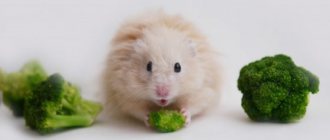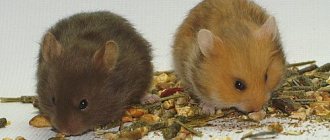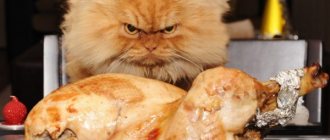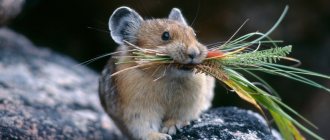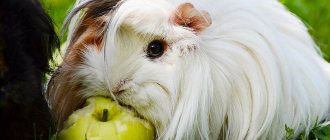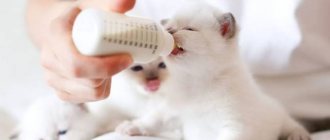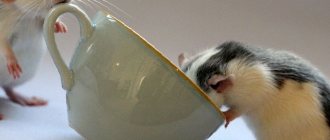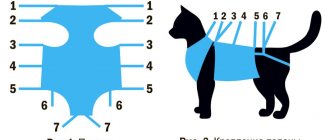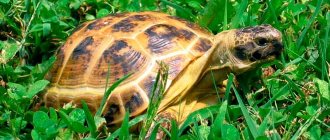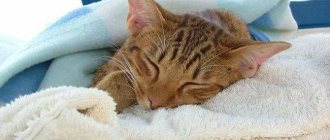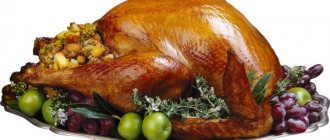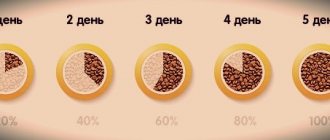Features of the body
Biology
The homeland of these animals is dry steppes and semi-deserts. Their digestive tract is not adapted to fatty, high-calorie, sweet foods. What dungarians eat in nature is a guideline for proper feeding of ornamental pets.
Wild hamsters feed mainly on grains and seeds. In the fall, the thrifty rodent seals the entrance to the hole, so in winter they only have access to dry food from reserves. In the spring they feed on green grass; in the summer, if possible, they feast on berries and insects.
The diet of a Djungarian hamster should consist of 65% carbohydrates, 16% protein, and 4-5% fat.
Like other rodents, Djungarians grow teeth throughout their lives. It is necessary to give the animal the opportunity to grind them down.
Metabolism
The main distinguishing feature of dzhungariks is their tiny size. This explains the high metabolic rate. Dwarf hamsters have a very fast metabolism and cannot go hungry. Compared to its larger counterparts, the dzhungarik is very gluttonous - it eats up to 70% of its own weight per day.
Predisposition to diseases:
- diabetes;
- obesity.
Overeating is the most common cause of metabolic disorders in hamsters. You should not feed your pet just for fun or because he is standing on his hind legs. Animals already choose the most delicious components from the food, which are also the most high-calorie. In confined spaces, care and feeding should be aimed at preventing excess weight.
The animal must be allowed out for a walk, active games are encouraged, and a running wheel is placed in the cage. Djungarian hamsters are fed a maximum of twice a day.
Diabetes mellitus is a consequence of obesity and genetic predisposition. Campbell's hamsters often suffer from this disease, but the difficulty is that in pet stores they uncontrollably crossbreed with Djungarian hamsters. An owner who does not purchase a rodent from professional breeders cannot be sure that it is not a hybrid.
Purposefully excluding foods rich in sugar from the Djungarian hamster's menu will only benefit the pet.
Why are cookies harmful?
Hamsters have a very low tolerance for sweets, salty and fatty foods. Especially harmful for Djungarian hamsters, which are predisposed to diabetes. You can occasionally offer your hamster dry, unsalted biscuits. But we are not immune from the fact that even such store-bought cookies contain a lot of harmful additives and chemicals. They have a detrimental effect on the liver and digestive tract of the rodent. Salt, which is very high in crackers, damages the heart and kidneys. As a result, the immune system weakens and other vital systems suffer. A hamster with a cookie looks very cute, crunches funny, and crumbs remain on its antennae. But you shouldn’t risk your pet’s health to admire this picture; it’s better to choose a healthy alternative to the treat.
Diet composition
Here's what Djungarian hamsters eat at home:
- grain mixture (dry food);
- succulent food (greens, grass, fruits, vegetables, berries);
- protein feed (dietary meat, eggs, insects);
- vitamin supplements;
- mineral stone, branches of fruit trees.
The basis of nutrition is industrial food for dwarf hamsters, a mixture of grain crops and freely available fresh drinking water. On such a diet, a hamster can live for a very long time, even without additional treats.
It is important to observe the measure: fruits should not make up more than 5% of the dzhungarik’s diet , even allowed ones are given in a piece no more than 1 cm. Vegetables are given every other day, and berries - no more than once a week.
Any new product is introduced into the diet in a tiny portion, with caution. also need to change dry food to a mixture from another manufacturer gradually , over the course of a week, to avoid digestive upset.
What should you not feed hamsters?
We have already written that domestic hamsters should absolutely not be given
any exotic fruits, hot, salty, peppery or too sweet, as well as fatty foods, for which the animal’s small digestive system is not designed at all.
This means that honey, any sweets, kozinaki, ice cream, halva and shortbread dough are contraindicated for a hamster: for a pet this is a slow-killing poison. The rodent's diet should be free of any milk, butter, cream, kefir and sour cream. Cabbage, fried meat, chocolate products, pasta, bread, breadcrumbs are contraindicated for your pet, as they contain an ingredient that is dangerous for the hamster. Yes, yes, don’t be surprised, hamsters should absolutely not be given bread, only grain.
Naturally, garlic, hot peppers, onions, and sorrel should not be given to a rodent. Do not forget about melons and watermelons, as well as apricot or cherry pits, which contain acid that is harmful to the hamster.
Every time, make sure that the hamster eats only fresh, unspoiled food and feed, ripe fruits and vegetables, and has the required amount of fresh water. This is the only way your playful pet will delight you and your family for a long time with its cheerfulness, activity and healthy appearance!
Apples are one of the most popular fruits in our latitude. We meet him almost every day in shops, bazaars, and in our own garden. It is a relatively cheap, easily accessible, tasty food for many pets.
Product table: what Djungarian hamsters can and cannot eat
Important! Even permitted products must be given with special frequency; to find out more, read the article to the end.
| You can give | Can't give | With caution or in small quantities |
| GRAINS | ||
| Oats | Pasta | Rice |
| Corn | Bakery products | Buckwheat |
| Wheat | Legumes: (peas, beans) | Lentils |
| Barley | ||
| Rye | ||
| SEEDS AND NUTS | ||
| Sunflower | Brazilian nut | |
| Pumpkin | Almond | |
| Linen | Pine nuts | |
| Cashew | Cherry, apricot pits | |
| Sesame | Acorns | |
| Walnut | Chestnuts | |
| Hazelnut | ||
| Peanut | ||
| VEGETABLES | ||
| Eggplant | Watermelon | Cucumber |
| Broccoli | Melon | Tomato |
| Zucchini | Potato | Radish |
| Carrot | Cabbage | Celery |
| Radish | Onion | Asparagus |
| Turnip | Garlic | Cauliflower |
| Beetroot (not sugar) | ||
| Pumpkin | ||
| Jerusalem artichoke | ||
| FRUITS | ||
| Apple | Persimmon | Apricot, plum |
| Pear | Citruses (orange, grapefruit, lemon) | Peach, nectarine |
| Banana | Exotic fruits (pineapple, kiwi, mango) | |
| BERRIES | ||
| Barberry | Honeysuckle | Grape |
| Hawthorn | Elder | |
| Cowberry | ||
| Pitted cherry | ||
| Strawberries and wild strawberries | ||
| Raspberries | ||
| Sea buckthorn | ||
| Rowan | ||
| Currant | ||
| Rose hip | ||
| GREENS, HERBS | ||
| Tops of carrots, beets | Sorrel | Parsley |
| Any salad (iceberg, corn) | Conifer branches | Dill |
| Clover | ||
| Nettle | ||
| Dandelions | ||
| Plantain | ||
| Leaves and branches of fruit trees (apricot, cherry, apple), other deciduous trees (birch, rowan, alder). | ||
| PROTEIN PRODUCTS | ||
| Cottage cheese 1% | Sausage | Boiled white fish |
| Low-fat white yogurt | Raw meat or fish | Peeled boiled shrimp |
| Boiled egg (chicken/quail) | Milk | Gammarus, daphnia |
| Boiled lean meat: beef, rabbit, turkey, chicken (breast). | Cheese | |
| Mushrooms | ||
Common sense will tell you what to feed your dwarf hamster at home.
Food should not contain SALT, SUGAR, SPICES, be too fatty or fried.
Any food from the human table is prohibited, but especially confectionery (cookies, ice cream, chocolate, kozinaki, honey, muesli).
Prohibited foods can be deadly
The list of what is prohibited is very extensive; in fact, there are much more prohibited products than can be covered in one article. But the list of what can be given to Djungarian hamsters from food is also impressive, so there is no point in experimenting with unsafe products. The ban may seem unreasonable, but there is always a reason.
Risk of poisoning
Some food that is familiar to us is real poison for the Djungarians . Almonds and apricot kernels contain hydrocyanic acid, watermelon accumulates nitrates, honeysuckle and elderberry cause suffocation and cramps. Potatoes may contain solanine. The problem is the small size of the animal and its sensitive body. Even a microscopic dose of a dangerous substance can cause intoxication.
Cause constipation
Any astringent products (persimmon) slow down intestinal motility due to the high content of tannins. Constipation is very dangerous for rodents.
Causes diarrhea
Foods that irritate the digestive tract or have a laxative effect should not be given to dwarfs. This is hot ginger and any spices that are found in human food (paprika, salt).
Cause fermentation
Intestinal bloating leads to the death of the rodent in a matter of hours. Foods that cause gas include cabbage, brown bread, and beans.
Too fat
The rodent's liver is not able to cope with foods that are too fatty. Even seeds, which are what Djungarians can eat, are given in moderation, and foods such as oil and fried foods are completely excluded. Avocado contains too much fat.
Cheek pouches hurt
Sometimes the product itself is not dangerous. But given the small size and habits of the pet, it causes problems. Dry pasta should not be given to your dwarf hamster, not because wheat is dangerous, but because it can injure its cheek pouches by stuffing spaghetti there.
Abscesses and inflammation of the sac are a serious problem that requires treatment. Owners, faced with such a nuisance, even first peel the seeds from the husks before feeding the jungarians.
Allergy risk
Essential oils, brightly colored fruits, vegetables and berries can cause allergies. If after eating strawberries your hamster’s eyes run, the skin turns red and itches, it should be excluded.
Sometimes a product is prohibited for several reasons: cheese is both salty, fatty and rich in lactose, which is very difficult to digest.
What are the benefits of a vegetable?
The vitamins and minerals contained in the orange root vegetable have a beneficial effect on the development and functioning of pets.
Important! Carrots purchased in retail stores contain a large amount of nitrates, which are quite toxic to the body of hamsters. Therefore, it is recommended to first soak the root vegetable slices in cold water for several hours to remove toxic substances from the pulp.
They include:
- vitamins: A, C, K, B1, B2, B6, PP, E, P - increase immunity, normalize vision, counteract colds, have a positive effect on the circulatory system of rodents;
- minerals: calcium, phosphorus, iodine, iron, chromium, etc. - normalize the functioning of the gastrointestinal tract;
- other substances: dietary fiber, protein, carotene, etc. - support the normal functioning of the body.
In addition, the solid structure of the vegetable helps maintain the physiological norm of tooth enamel and uniform grinding of the incisors during the process of chewing food, and the juice contained in the pulp helps quench thirst.
Rules for feeding permitted products
The diet of Djungarian hamsters should be varied: the same foods should not be given day after day (except for dry food). It is optimal if the hamster receives dry, juicy and protein food every day. You cannot have a “vegetable” or “meat” day.
Djungarians love to stock up, so it is not recommended to give treats in large pieces: the product will deteriorate and rot if buried in the house. Inventory audits are carried out regularly. A piece of 1 cm in size will be optimal for a dwarf hamster.
How often can you feed your dwarf with additions to dry food?
- fruits and berries – once every 2 weeks;
- greens - every other day, preferably dried;
- vegetables - white or green every day (zucchini, Jerusalem artichoke, cucumber, turnip) others (pumpkin, carrots) - 2 times a week;
- nuts and seeds – rarely, as a delicacy;
- meat, eggs - once a week.
The recommendations do not take into account special needs: for example, a pregnant female can eat protein foods 2-3 times a week.
All products must be fresh and of high quality.
When feeding vegetables and fruits, preference is given to seasonal products. All succulent food is not only washed thoroughly, but they try to get rid of the “chemical” component (nitrates, pesticides). The greens are soaked, the apple is peeled.
In winter, you can’t help but think about what to feed the dzhungarik: overseas tasteless tomatoes and it’s scary to eat yourself. A good alternative to greenhouse vegetables would be oat, wheat, sunflower sprouts, and greens frozen from the summer.
Feed with caution
Dwarf hamsters, which include Djungarian hamsters, are prone to diabetes, so fruits and berries should be fed in moderation and carefully.
If you want to diversify your homa's diet with fresh foods, then instead of fruits, you can focus on vegetables.
Below is a list of vegetables, fruits and berries that, in moderate quantities, will not harm the health of the dwarf, but on the contrary, will replenish the supply of vitamins and nutrients.
Fruits and berries:
- Apple.
- Banana.
- Peach.
- Cherries.
- Plum.
- Blueberry.
- Rose hip.
- Strawberry.
- Grushka.
- Grape.
Fruits can be offered to Djungarian hamsters after they reach two months of age.
Make sure that no half-eaten pieces are left in the cages; they spoil quickly and can ultimately lead to poisoning of the rodent. Some varieties of pear have a laxative effect, so it should be introduced gradually and in small quantities.
Vegetables:
- Zucchini.
- Chinese cabbage.
- Eggplant.
- Cucumber.
- Radish.
- Radish.
- Cauliflower.
- Pumpkin.
- Tomato.
- Beet.
- Green beans.
- Fresh corn.
- Carrot.
Tomatoes can be fed to homa if they are grown in your garden, since the varieties sold on the market often contain a lot of pesticides.
A similar rule is fully applicable to cucumbers. Beets will not harm your pet, but they actually do not contain any beneficial substances. But carrots must be included in the homa diet.
Dried fruits:
- Banana chips.
- Dried apples.
- Dried pears.
- Dried apricots.
- Raisin.
Fruits and vegetables grown yourself or purchased from safe places will be a big plus.
Poisoning people with pesticides is far from uncommon, let alone such miniature creatures, for which such a dose would be fatal. As for dried fruits, due to their high sugar content, they should be given in small quantities.
Do not allow dzhungarik to eat citrus fruits, they are harmful for such a small organism, this rule also applies to sour berries, such as barberry or sea buckthorn. Tropical fruits should be avoided in the homa diet, with the exception of bananas or banana chips.
Choosing dry food
The diet of jungarians consists of 80-90% dry food. The hamster should receive it every day, this is the basis of the diet. Djungarian hamsters eat little (about a tablespoon of food per day), which means you shouldn’t skimp on store-bought formulas. Let's consider several brands of proven products:
Food for dwarfs
Versele-Laga "Prestige Mini Hamster Nature"
The completely balanced composition, in addition to grains and seeds, contains dried vegetables, fruits and nuts, a protein component and yeast as a source of vitamins. If your pet is prone to obesity, you need to manually select pineapple and raisins.
Chika-Bio "Food for Djungarian hamsters"
Domestic food, not inferior in quality to imported analogues, but more affordable. The size of the food particles and the ratio of ingredients are selected specifically for feeding jungarians.
Food for hamsters of any type of excellent quality
JR Farm Hamster
It has high palatability: dungarians feed by eating the entire food, rather than choosing individual tasty components. The “chips” of the food are a variety of protein sources (mealworms, chicken, tiny fish), the prebiotic inulin, which improves digestion, and yucca extract, which reduces rodent odor.
Vitakraft Menu Vital
Usually used for Syrians. The downside is that honey is added to the mixture to improve the taste. The diet of Djungarian hamsters involves limiting sugars.
Fiory Criceti
For dzhungariks, this food does not contain enough protein, and you will have to manually select appetizing, but harmful honey granules.
Cunipic
This food is characterized by a relatively poor composition.
Vitapol and Lolo pets
It is better to store hamster food not in a bag, but pour it into a glass jar with a tight lid. The mixtures are complete: you can give your Djungarian hamster only dry food for a long time. The reason to diversify the diet is the special physiological status of the animal: growth period, pregnancy and lactation, mating time for the male.
On our website you can learn about the correct feeding regime for a hamster. These are important rules that can protect your pet from obesity and poisoning.
Rules for feeding dzhungariks
Owners of these funny hairy rodents need to remember that the animals' diet must be balanced, varied and consist of fresh, chemically safe foods.
In the wild, the animal’s diet consists of:
- carbohydrates – 65%;
- proteins – 15%;
- fats – 5%.
The hamster has a fast metabolism, and during the day the hamster eats a volume of food equal to 70% of its body weight. In addition, this type of rodent is predisposed to diabetes and obesity.
These factors must be taken into account when feeding the animal.
Diet
There is no consensus on the diet of the dwarf dog among experienced breeders and veterinarians. Some recommend feeding the animal once a day, in the evening, since the hamster is nocturnal and is most active in the twilight hours . Others insist on giving food twice: after the pet wakes up in the morning and in the evening. Observe your hamster to determine the best feeding schedule for him.
An adult hamster needs 1 tablespoon of ready-made food per day. If you feed twice, then give about 2/3 of a spoon in the evening, and 1/3 in the morning. And make sure that the food comes at the same time.
For a long time it was believed that the hamster does not need water, since he is a resident of semi-desert areas and he gets enough moisture from juicy vegetables and fruits.
In fact, in nature, dungarians drink dew from the grass, albeit in small quantities. Therefore, it is necessary to give water to your hamster. Fresh filtered or bottled still water is suitable for this. Raw tap water is not suitable, because... contains many impurities, hardness salts and chlorine. Even boiling does not remove these substances.
The water in the drinking bowl is changed every day, and once a week the drinking bowl is thoroughly washed and disinfected.
IMPORTANT! The drinking bowl should not be placed in direct sunlight to prevent algae from multiplying in the water.
Vitamins for dzungarians
Pet stores sell special vitamin preparations for hamsters. They are produced in the form of liquid concentrates and tablets. Please consult your veterinarian before purchasing these products. Manufacturers have already included vitamin supplements in many grain mixtures for hamsters.
But be sure to offer a mineral stone to your hamster. The animal will not only grind its teeth, but will also replenish the body with useful substances.
Basic mistakes and how to avoid digestive problems
Errors in compiling a diet for dzhungarika arise due to insufficient knowledge of its species characteristics and the influence of various products on the animal’s body. And the desire to feed your pet food from the table leads to serious digestive problems in the rodent.
